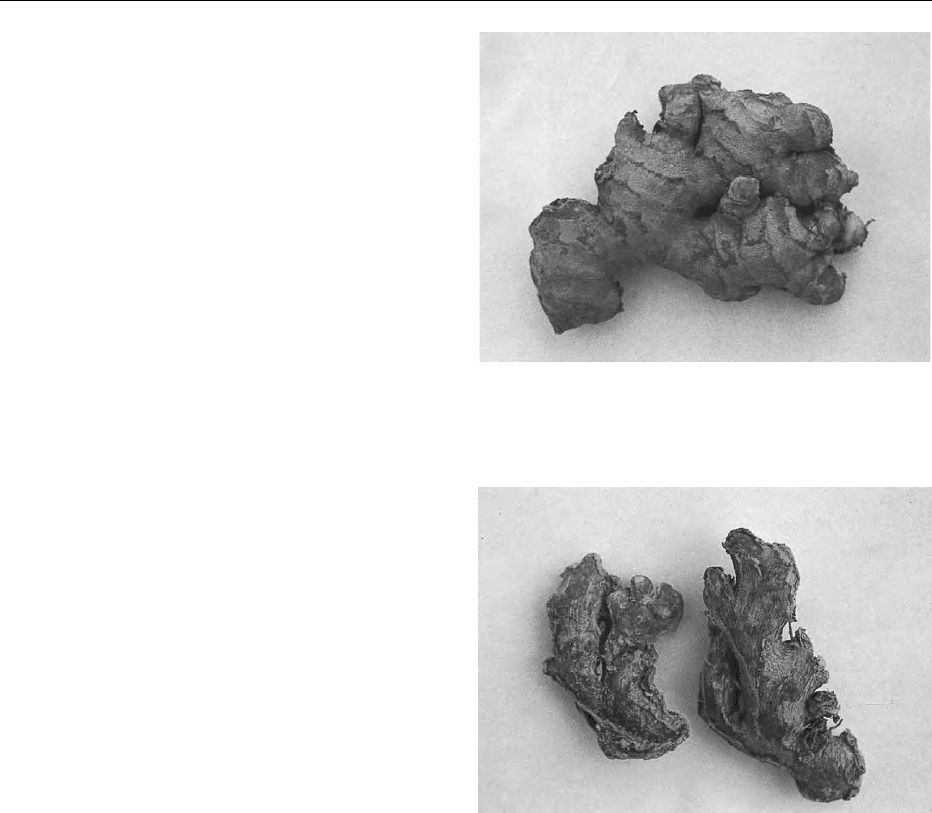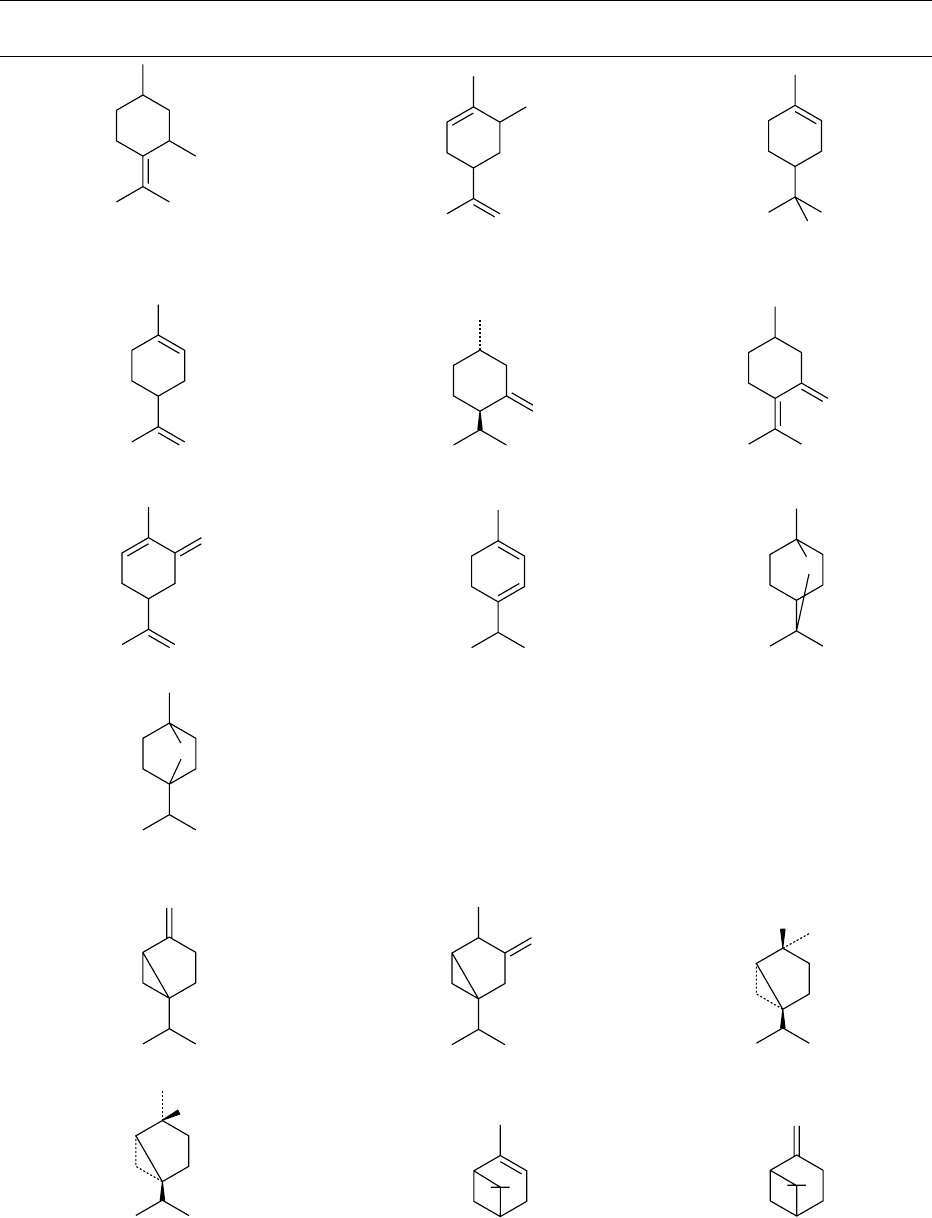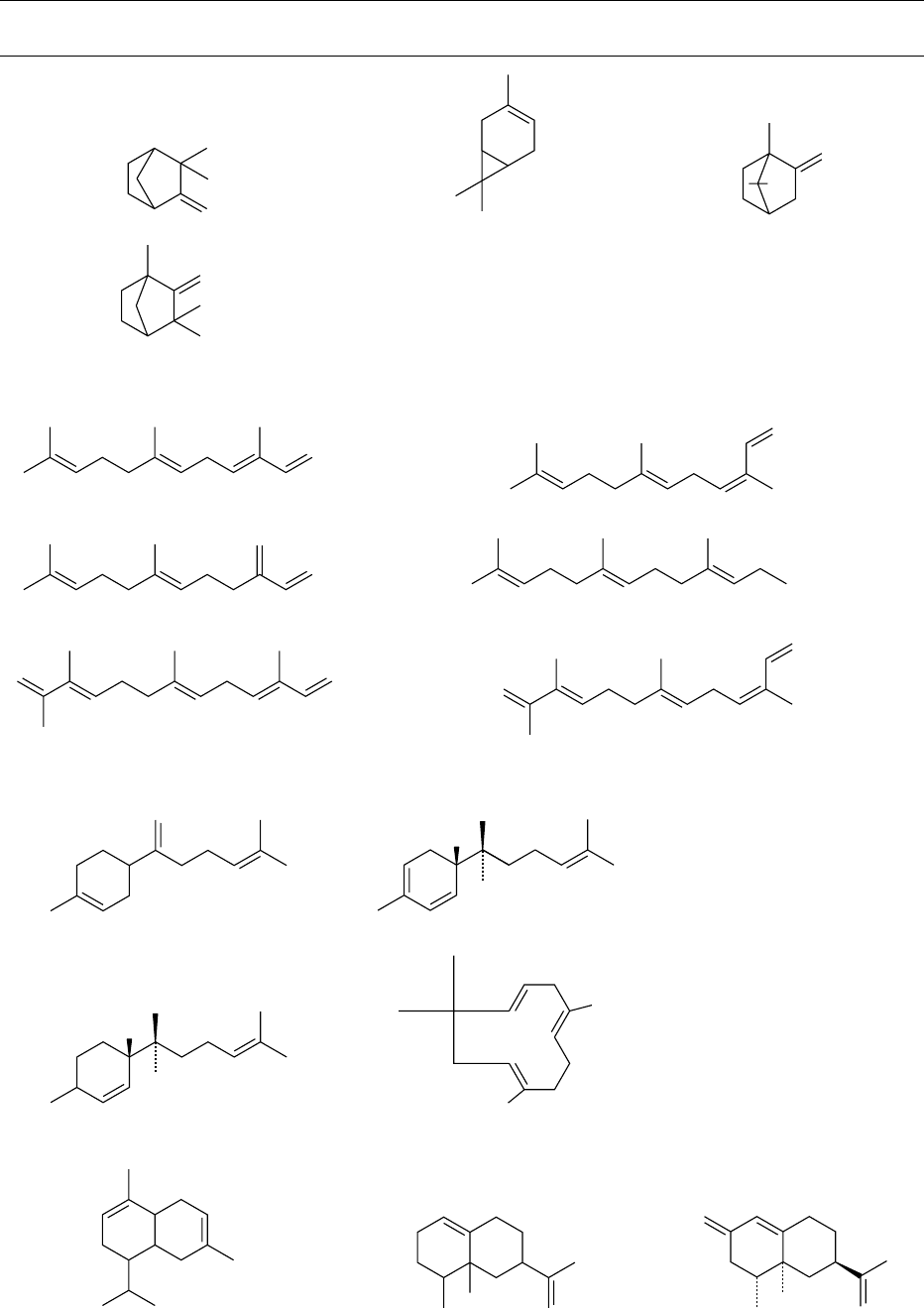Caballero B. (ed.) Encyclopaedia of Food Science, Food Technology and Nutrition. Ten-Volume Set
Подождите немного. Документ загружается.


‘setts.’ It is also grown both as a pure crop and as an
intercrop. It may be grown in rotation with paddy-
rice, samai (Panicum miliare). If irrigation facilities
are available, ginger may be rotated with vegetables,
chilli, groundnut, ragi (Eleucine coracana) and maize.
Ginger is sometimes grown mixed with turmeric,
which grows rapidly early on and provides partial
shade to the developing ginger. It is harvested at dif-
ferent stages depending upon the requirements of the
user. Green ginger is harvested between 5 and 7
months after sowing, and the rhizomes are used for
preservation as preserved ginger. Final harvesting is
carried out after 8–10 months from planting for the
production of dried ginger. Shriveling, yellowing, and
withering of the leaves, accompanied by drying and
lodging of the aerial shoots, indicate maturity of the
rhizomes.
000 6 The maturity of the rhizome has a significant influ-
ence on both its quality characteristics and its suit-
ability for processing into preserved or dried ginger.
The optimum time for harvesting ginger in India is
245–260 days from planting, after which the rhi-
zomes become more fibrous. Harvesting of the
mature ginger is mostly done by hand using a spade,
hoe, or digging fork. In advanced countries, the late
crop is also harvested by mechanical diggers. Extra
care is required for the harvesting of healthy rhi-
zomes. The soil, roots and shoots are subsequently
removed, and the rhizomes are carefully washed and
dried for storage. See Plates 1 and 2.
000 7 Several commercial types of ginger are recognized
in cultivation, which are generally named after the
localities where they are grown. The types with less
fiber, which varies from 1.7 to 9.0%, have a higher
demand. Some of the prized types of ginger in inter-
national trade include Jamaican ginger, Indian ginger,
African ginger, and Chinese ginger, and these vary in
taste and aroma.
000 8 Since the rhizome is perishable, it is susceptible to
attack by the soilborne fungi, insects, and white ants.
Rhizome rot or soft rot is the most serious disease
found all over the ginger-growing areas of the world.
Healthy and disease-free rhizomes are thus selected
for storage. The use of specific fungicides for the
treatment of rhizomes before storage is recommended
on a regional basis. The treated rhizomes are air-dried
under shade to remove excess moisture. The optimum
conditions for the storage of fresh ginger have been
investigated in detail in Hawaii. Harvested rhizomes
should be washed immediately and then air-dried in
the shade for 1–2 days. The rhizomes can be stored
safely for up to 6 months by maintaining the tempera-
ture at 12
C and the relative humidity at 65%.
000 9 In India, the ginger is loosely stored in pits, which
may be up to 1m deep. These pits are cool and
provide protection against sunlight. A layer of sand
or sawdust is spread at the bottom of the pit before
storing the rhizomes. The pit is left uncovered or
covered with a wooden plank, which in turn is
plastered with mud, with a hole in the center for
aeration.
0010As mentioned earlier, there are three primary
products of ginger rhizomes: fresh or green ginger,
preserved ginger in syrup or brine, and dried ginger.
Green ginger is consumed mostly in the areas of
production and nearby places. Preserved and dried
products are the major forms in which ginger is
traded internationally. Dried ginger is used as a
spice and also for the preparation of its extracts.
0011Commercial preparation of preserved ginger is
mostly practiced in China, Hong Kong, Australia,
and India. Young juicy rhizomes are dried, cleaned,
and boiled in water until they become tender. They
fig0001Plate 1 (see color plate 130) Spices and flavouring crops:
Rhizome of green ginger (Zingiber officinale).
fig0002Plate 2 Spices and flavouring crops: Rhizome of dried ginger
(Zingiber officinale).
SPICES AND FLAVORING (FLAVOURING) CROPS/Tubers and Roots 5487

are then peeled, scraped, and boiled several times in a
sugar solution. Sometimes, preserved ginger is also
prepared in the dry state by dusting the drying
rhizomes with crystalline sugar.
0012 The preparation of dried ginger involves processing
the cleaned rhizomes by peeling, splitting them into
pieces, immersing them into boiling water for about
10 min, and, finally, drying. The appearance of pro-
cessed ginger (black or white), the contents of volatile
oil and fiber, the pungency level, and an assessment of
the aroma and flavour are important in the quality
evaluation of dried ginger.
0013 The characteristic pleasant and aromatic odor of
ginger is due to essential oil, which can be separated
from the dried rhizome by steam distillation. The
essential oil, known in the trade as ‘oil of ginger,’ is
greenish to yellow in color, mobile (viscous on aging),
with the characteristic warm and aromatic odor, but
not the pungent flavor of the spice. The pungent
principles of ginger are nonvolatile oleoresin, com-
monly known in the trade as ‘gingerin.’ This can be
extracted from dried ginger by percolation with a
suitable solvent. It is a viscous and dark brown oil
and retains the full pungency of the spice. Besides the
pungent principles, the oleoresin also contains
gingerol, shogaol, and zingerone.
0014 In medicine, ginger is used as a carminative and
digestive stimulant. It also dilates the blood vessels
in the skin, causing a feeling of warmth. Its prepar-
ations are also useful in the treatment of coughs
and colds. Ginger is extensively used in culinary
preparations such as soups, puddings, pickles,
gingerbread, and cookies, and is an ingredient of all
curries, except those used with fish. Ginger is also
popular for flavoring beverages such as ginger ale
and ginger beer.
Turmeric
0015 Turmeric, another important spice, is also obtained
from the underground plant part, i.e., the stem. The
plant, a native of south-east Asia, is widely cultivated
in India, Sri Lanka, Indonesia, China, Taiwan, Peru,
Haiti, and Jamaica, of which India is by far the largest
exporter.
0016 Turmeric is obtained from the rhizomes of Cur-
cuma domestica Val. (syn. C. longa L.), also a
member of the family Zingiberaceae. The plant is a
robust perennial herb with a short stem and tufted
leaves. The rhizomes, brownish yellow in color, con-
sist of a central bulbous portion bearing a number of
finger-like lateral offshoots. Although the character-
istic yellow matter is distributed throughout the
plant, it is highly concentrated in the rhizome. There
are several varieties of turmeric distinguished by
the names of the localities in which they are grown.
Turmeric cultivated in the hills is said to be of a better
quality than that raised in the plains. Even the same
variety which is grown in plains and on the hills
shows distinct differences in quality and yield. See
Plate 3.
0017Cultivation of turmeric requires a hot and moist
climate, a liberal water supply, and a well drained
soil. It can be grown successfully in rice fields on
raised beds beyond the reach of stagnant water. It is
usually rotated with ragi (a cereal grass cultivated in
Africa and Asia), paddy, and sugarcane. It is rarely
cultivated as a pure crop and is usually grown mixed
with castor bean, maize, ragi, onions, brinjal, and
tomato. The plants thrive well in partially shaded
areas, but shade adversely affects the yield.
0018Turmeric is a good host for many pathogenic
microorganisms and insectpests. Rhizome rot and
leaf spot caused mainly by Taphrina maculans Butler
are the important diseases of turmeric. The use of
Bordeaux mixture or any other nonmetallic fungicide
has been suggested as a remedy.
0019The crop is ready for harvesting in about 9–10
months, when the lower leaves turn yellow. The rhi-
zomes are carefully dug up with hand-picks. The leafy
tops are then cut off, and the roots are removed. The
adhering soil particles are removed by brisk shaking
or by rubbing, and the rhizomes are then thoroughly
washed with water, placed in small heaps, covered
with turmeric leaves, and left to dehydrate. The
fingers and bulbs (or mother rhizomes) are then
separated and cured separately.
0020The curing of turmeric involves boiling or steaming
the fresh rhizomes in water, followed by drying and
polishing. The rhizomes are boiled for 45–60 min
fig0003Plate 3 (see color plate 131) Spices and flavouring crops:
Rhizome of turmeric (Curcuma domestica).
5488 SPICES AND FLAVORING (FLAVOURING) CROPS/Tubers and Roots

over a slow fire until they become soft. The rhizomes
are then cooled and spread out to dry in the sun.
Boiling of the rhizomes in very dilute solutions
(0.05–0.1%) of mild alkali modifies the color of the
core of the rhizome to the desired yellow–orange. The
duration of boiling markedly affects the color and
aroma of the final product. After boiling, the rhi-
zomes are dried in sunlight for 10–15 days. Sun-
drying gives rise to a surface-bleaching effect. After
drying, the rhizomes become quite hard and brittle,
and break with a metallic sound. Drying is followed
by polishing, which includes cleaning off the outer
skin, rootlets and adhering particles of soil, and
making the rhizomes smooth. Polishing is performed
either manually or in power-operated drums. The
dried turmeric is coated with a slurry of turmeric
powder in the course of polishing to impart a better
color to the rhizomes.
0021 The cured rhizomes are stored in pits dug at a
raised site. The bottom and sides of these pits are
lined with Saccharum spontaneum (commonly
known as Rellu grass) and palmyrah mats. The pits,
after being filled with cured turmeric, are covered
with mats and grass and, finally, with earth. The
produce may be stored for a year. The turmeric is
also stored in ‘godowns’ or warehouses in gunny
bags.
0022 The coloring matter of turmeric is yellowish
crystalline curcumin, which can be extracted from
the powder either by direct solvent extraction or by
extraction with alkali and subsequent precipitation
with acid.
0023 Turmeric is mainly used for domestic culinary prep-
arations and is an important constituent of curry
powder. Turmeric is also used as coloring agent in the
textile, food, and pharmaceutical industries. In the
Indian system of medicine, turmeric is used to some
extent as a stomachic (i.e., promoting the appetite or
assisting digestion), tonic, and blood purifier. The
juice of the fresh rhizome is used as an antiparasitic
for many skin diseases. Oil of turmeric, distilled from
the dried rhizome, shows antiseptic properties.
Minor crops
Spices obtained from Roots
0024 Angelica Angelica has been in use as a spice since ad
1500. It is obtained from the roots of Angelica arch-
angelica L., a member of the family Apiceae. It is
native to Syria but is known to occur in many parts
of Europe and western Asia. In India, it is grown in
the Kashmir valley.
0025 The plant is a stout perennial herb with large,
pinnately compound leaves and small, greenish
white flowers. The dry rootstocks yield 0.35–1% of
essential oil, the main constituent of which is
b-phellandrene. The roots contain several furocou-
marins such as angelicin, bergapten, xanthotoxin,
etc. in addition to umbelliprenin and several phenols.
The dried roots are frequently used for flavoring
cakes, candy, and beverages. Angelica root is the
main flavoring ingredient of gin. It is also used in
perfumery and medicine. In medicine, the roots have
been shown to possess stimulant, expectorant, and
diaphorectic (i.e., inducing perspiration) properties.
0026Horse-radish The horse-radish (Armoracia lapathi-
folia Gilib.) is a member of the family Brassicaceae
and has been in use as a condiment since ancient
times. The plant is a native of southeastern Europe
and is widely grown in Europe, America, and the hilly
regions of India.
0027The plant is a tall, hardy herb with glossy green,
toothed leaves. The roots are fleshy, yellowish white,
and cylindrical. Initially, the root is about 2.5 cm in
diameter, but it may reach a length of 1 m. The Eng-
lish refer to the plant as ‘red cole,’ perhaps due to the
hot sensation experienced when ingesting even small
pieces of root. The roots are dug up and are scraped
or grated before use. Both fresh and dried roots are
used as a condiment, which aids digestion and pre-
vents scurvy. It is similar to mustard in most of its
properties. The smell and flavor of horse-radish come
from the glycoside sinigrin, which decomposes in
the presence of water by enzyme action to form mus-
tard oil.
0028Asafoetida Asafoetida is the dried latex obtained
mainly from living rootstocks or tap roots of several
species of Ferula, namely F. foetida Regel., F. alliacea
Boiss., F. rubricaulis Boiss., F. asafoetida Linn., and
F. narthex Boiss, of the family Apiaceae. The
plants are perennial herbs which are mainly distrib-
uted from the Mediterranean region to Central
Asia. The main regions of asafoetida production are
eastern Iran and Western Afghanistan. Some species
are also found in the Punjab and Kashmir regions
of India.
0029The plants bear large, carrot-shaped roots, 10–
15 cm in diameter at the crown after 4–5 years of
growth. At the time of flowering, the upper part of
the root is laid bare, and the stem is cut off close to the
crown. The exposed surface is covered by a dome-
shaped structure made up of twigs and mud. The
exudate (milky juice) oozing out from the cut surfaces
is scraped off after a few days. The collection of the
resin and the slicing of the root are repeated until
exudation ceases.
0030Asafoetida occurs in three forms in commercial
trade: tears, mass, and paste. The tears make the
SPICES AND FLAVORING (FLAVOURING) CROPS/Tubers and Roots 5489

purest form of resin, it is bitter and acrid in taste and
emits a strong and peculiar odor.
0031 Asafoetida contains mainly resin (40–64%), gum
(25%), and volatile oil (10–17% on a dry-weight
basis). The resin portion consists mainly of asaresino-
tannol, free or combined with ferulic acid. Umbelli-
ferone seems to be present in combined state. Oil of
asafoetida is obtained by steam distillation of the gum
resin.
0032 Asafoetida is generally used for flavoring curries,
sauces, and pickles. Medicinally, it stimulates the in-
testinal and respiratory tracts and the nervous system.
It is useful in asthma, whooping cough, and chronic
bronchitis.
0033 Sarsaparilla Sarsaparilla is obtained from the dried
roots of several tropical species of Smilax, a member
of the family Liliaceae. Some of the important spice-
yielding species include S. aristolochiaefolia Mill.
(Mexico), S. officinalis H.B. & K. (Honduras), and
S. regelii Killip & Morton (Jamaica). The plant
thrives best in hot and humid climates and on light,
well-drained sandy loam rich in humus.
0034 The plants are climbing or trailing vines with
prickly stems. The rhizomes are short and thick,
with very long, thin roots. The plants are harvested
after attaining 2–3 years of age. They are carefully
dug up and cut off near the stock, which is then
covered up again with surface soil. The harvested
roots are then washed well, dried in the sun, and
tied up in bundles. The roots contain a bitter principle
which is used as a flavoring agent. It is chiefly used as
a beverage condiment for the preparation of soft
drinks. Sarsaparilla is mostly used in combination
with winter green and other aromatic plants.
0035 Medicinally, sarsaparilla has been used to treat
syphilis and other skin diseases.
Spices obtained from Rhizomes or Tubers
0036 Zedoary Zedoary (Curcuma zedoaria Rosc. syn.
C. zerumbet Roxb.) closely resembles turmeric
(C. longa) in appearance. It is a native of northeast
India and is widely cultivated in many parts of China,
Sri Lanka, and India.
0037 The plant bears green leaves with brownish purple
veins and grows up to a height of 50 cm. The rhizomes,
which are large and fleshy, are cut into small pieces and
dried. Dried slices have a bitter and strong, camphor-
aceous taste and are used for commercial purposes.
0038 Steam distillation of the rhizome yields a light
yellow oil. The odoriferous consitutent is said to be a
sesquiterpene alcohol belonging to the tricyclic group.
0039 Zedoary was an important spice in the past, but
these days, it is usually used only for flavoring li-
queurs and curries. The rhizomes have aromatic,
stimulant, and carminative properties. Besides its
use as spices, the rhizomes are also used for the prep-
aration of shoti starch (flour), a substitute for arrow-
root and barley. It is highly valued as a dietary item,
especially for infants and convalescents. A red
powder, ‘abir,’ is also prepared from powdered rhi-
zomes by treatment with a decoction of sappan wood.
0040Mango ginger Mango ginger (Curcuma amada
Roxb.) is a member of the family Zingiberaceae. The
plant is native to India and occurs in the wild state in
parts of Bengal, Konkan, and Madras. See Plate 4.
0041The plants are herbaceous, and the rhizomes have
the characteristic odor of green mangoes. At the time
of harvesting, entire plants are lifted up with a crow-
bar, and the rhizomes are collected, cleaned, and
dried in the shade. On distillation, the rhizome yields
essential oil, which consists mainly of pinene, oci-
mene, and linalool. The rhizome is mostly used in
pickles and is considered stomachic and carminative.
It is also applied over contusions and sprains.
0042Galangal Galangal is of three types: lesser galangal,
greater galangal, and light galangal. The reddish-
brown rhizomes are used as condiment and have an
aromatic spicy odor and a pungent taste.
0043The lesser galangal (Alpinia officinarum Hance.), a
member of the family Zingiberaceae, is a native of
southern China. The plant is a perennial herb with a
raceme of showy flowers and attractive foliage. The
rhizome is smaller and has a stronger odor and taste.
The lesser galangal is used as a spice in cooking, and
also in medicine and for flavoring liqueurs. It is also
used to impart a pungent flavor to vinegar.
0044The greater galangal (Alpinia galanga (L.) Willd.)
is also a perennial herb with showy flowers and
fig0004Plate 4 (see color plate 132) Spices and flavouring crops:
Rhizome of mango ginger (Curcuma amada).
5490 SPICES AND FLAVORING (FLAVOURING) CROPS/Tubers and Roots

beautiful foliage. It is commonly found in Indonesia
and Malaysia, and is also cultivated in Bengal and
southern parts of India. The green rhizomes contain
essential oil consisting mainly of methyl cinnamate
and cineol. It gives a pungent taste like a mixture of
pepper and ginger. Medicinally, it is useful in respira-
tory troubles, especially in children. The rhizomes are
also carminative and stomachic.
0045 The light galangal (Alpinia speciosa (Wendl.) K.
Schum) is a native of the Eastern Archipelago, off
the Coromandel Coast of south-east India. Its rhi-
zome is much larger and is generally used as substi-
tute for greater galangal, and even as a substitute for
ginger in many preparations.
See also: Spices and Flavoring (Flavouring) Crops: Use
of Spices in the Food Industry; Properties and Analysis
Further Reading
Akamine EK (1962) Storage of Fresh Ginger Rhizomes.
Bulletin No. 130. University of Hawaii: Hawaii Agricul-
ture Experimental Station, Hawaii.
Anon. (1976) The Wealth of India. Raw Materials. New
Delhi: Council of Scientific and Industrial Research.
Hirasa K and Takemasa M (eds) (1998) Spice Science and
Technology. New York: Marcel Dekker.
Kochhar SL (1981) Economic Botany in the Tropics.
Madras: Macmillan.
Parry JW (1969) Spices: The Story of Spices, vol. I. New
York: Chemical Publishing Company.
Pruthi JS (1976) Spices and Condiments. New Delhi:
National Book Trust.
Purseglove JV, Brown EG, Green CL and Robbins SRJ
(1981) Spices, vols. I and II. London: Longman.
Rosengarten F Jr. (1969) The Book of Spices. Philadelphia,
PA: Livingston.
Simpson BB and Connez-Ogorzaly M (1986) Economic
Botany: Plants in our World. New York: McGraw Hill.
Watt G (1972) Dictionary of the Economic Products of
India, vol. VI. New Delhi: Cosmo.
Properties and Analysis
C Jian Qin, Perfumery Research and Development
Center of Yunnan, Kunming, Yunnan, China
This article is reproduced from Encyclopaedia of Food Science,
Food Technology and Nutrition, Copyright 1993, Academic Press.
Background
0001 In the vegetable kingdom, there are many plants that
are odorous. A range of spices used in foods is shown
in Table 1. This article reviews the properties of these
odor-bearing molecules as well as the technology of
extraction. In addition to their odorant properties,
many herbs and spices have an important effect on
taste, as well as heating/cooling in the mouth. (See
Flavor (Flavour) Compounds: Structures and Charac-
teristics; Sensory Evaluation: Aroma; Taste.)
Range of Compounds Present
0002The odorants are chemically mainly of three types,
and they can be present in any organ of the plant,
such as the seed, fruit, flower, leaf, root, rhizome, and/
or bark, even in moss. Some of the more important
compounds found are shown in Table 2, with their
structures in Table 3.(See Essential Oils: Properties
and Uses.)
Terpenes
0003Most odorous compounds present in plants are
monoterpenes, sesquiterpenes, and their derivatives.
This kind of compound is derived from secondary
metabolites of biosynthesis via coenzyme A. Their
chemical structure is essentially formed by a number
of units of 2-methylbutadiene (trivially called iso-
prene), so that their general formula is (C
5
H
8
)
n
.Ifn
equals 2, the compound is called monoterpene; if
n equals 3, it is called a sesquiterpene, and so on.
Derivatives of Phenylpropane
0004Although this type of compound is less widely distrib-
uted than the terpenes, it is very important from the
fragrance point of view, for example, trans-anethole
in anise and star aniseed oil and cinnamic aldehyde in
cinnamon bark oil. These compounds are also prod-
ucts of secondary metabolites; in comparison with
terpenes, biosynthesis is via shikimic acid, which is
an intermediate in the synthesis of lignin.
Aliphatic, Heterocyclic, and Phenolic Compounds
0005The third type of flavoring compounds consist of
derivatives of aliphatic heterocyclic and phenolic
compounds. These compounds can be associated
with the two preceding types of odorants as minor
compounds in essential oils. However, they are fre-
quently encountered; for example, 6-methyl-5-hep-
ten-2-one is found in most citrus essential oils. Some
plants contain only aliphatic and heterocyclic com-
pounds without either terpenes or derivatives of phe-
nylpropane; for example, rose, jasmine, and violet.
They are found in the plant in the flowers, leaves,
and/or fruits. (See Phenolic Compounds.)
0006These compounds can belong to a wide variety of
chemical groups:
SPICES AND FLAVORING (FLAVOURING) CROPS/Properties and Analysis 5491

.0007 Aldehydes, alcohols, esters, ketones, and lactones,
which are formed by the metabolism of lipids and
glycosides.
.
0008 Phenols, which result from the metabolism of pro-
teins and glycosides.
.
0009 Sulfides and nitrogenous compounds (mercaptans,
thiophenes, thiazoles, pyrazines and pyridines),
which arise from the metabolism of proteins.
.
0010 Carboxylic acids, which come from the metabol-
ism of sugars and glycerides.
They have a delicate fragrance and are generally
responsible for floral notes and fruit flavor; their
odor, therefore, is very different from that of terpenes.
It must be noted that the heterocyclic compounds can
be formed not only by biosynthetic processes but
also by fermentation by microorganisms or thermal
reactions, including the Maillard reaction. (See
Browning: Nonenzymatic.)
Extraction and Isolation
Process Using Water Vapor
0011Essential oils can be produced by use of water vapor.
The term ‘oil’ refers to their lipophilic nature, which
causes them to separate from aqueous distillate. The
adjective ‘essential’ refers to its origin in a living
plant. (See Essential Oils: Isolation and Production.)
tbl0001 Table 1 Spices used in food preparation/processing
Type and number Common name Latin name Class/order family (bot) Cultivation region
Fruits
1 Pepper, black Piper nigrum Piperaceae Tropical and subtropical regions
2 Vanilla Vanilla planifolia Orchidaceae Madagascar, Comore Island,
Mexico, Uganda
3 Allspice Pimenta dioica Myrtaceae Caribbean Islands, Central America
4 Paprika (red pepper) Capsicum annuum Solanaceae Mediterranean and Balkan region
5 Bay tree
a
Laurus nobilis Lauraceae Mediterranean region
6 Juniper berries Juniperus communis Cupressacceae Temperate climate region
7 Chilli Capsicum frutescens Solanaceae Tropical region
8 Aniseed Pimpinella anisum Apiaceae
Temperate climate region
9 Caraway Carum carvi Apiaceae
9
>
=
>
;
10 Coriander Coriandrum sativum Apiaceae
11 Dill
a
Anethum graveolens Apiaceae
Seeds
12 Mustard Sinapis alba
b
Brassicaceae
o
Temperate climate region
Brassica nigra
c
Brassicaceae
13 Nutmeg Myristica fragrans Myristicaceae Indonesia, Sri Lanka, India
14 Cardamom Elettaria cardamomum Zingiberaceae India, Sri Lanka
Flowers
15 Clove Syzygium aromaticum Myrtaceae Indonesia, Sri Lanka, Madagascar
Rhizomes
16 Ginger Zingiber officinale Zingiberaceae South China, India, Japan,
Caribbean Islands, Africa
17 Turmeric Curcuma longa Zingiberaceae India, China, Indonesia
Barks
18 Cinnamon Cinnamomum zeylanicum,
C. aromaticum,
C. burmanii
Lauraceae China, Sri Lanka, Indonesia,
Caribbean Islands
Roots
19 Horse-radish Armoracia rusticana Brassicaceae Temperate climate region
Leaves
20 Parsley Carum petroselinum Apiaceae Temperate climate region
21 Marjoram Origanum majorana Lamiaceae Temperate climate region
22 Oregano Origanum heracleoticum,
O. onites
Lamiaceae Temperate climate region
23 Rosemary Rosmarinus officinalis Lamiaceae Mediterranean region
24 Sage Salvia officinalis Lamiaceae Mediterranean region
25 Thyme Thymus vulgaris Lamiaceae Temperate climate region
a
Fruits and leaves.
b
White mustard.
c
Black mustard.
From Belitz H-D and Grosch W (1987) Food Chemistry. Berlin: Springer.
5492 SPICES AND FLAVORING (FLAVOURING) CROPS/Properties and Analysis

0012 Steam distillation This process, which is an indirect
distillation, involves putting raw materials above the
vapour current without previous maceration. The
saturated vapors bearing volatile organic compounds
are condensed on a cold surface, and the essential oil
is recovered by decantation. This process allows
treatment of raw materials that are heat-sensitive.
0013 Hydrodistillation In this case, the raw materials are
immersed in boiling water. The volatile compounds
are carried away with the water vapor and collected
after condensation and decantation, as in steam
distillation.
001 4 Hydrodistillation is generally carried out at atmos-
pheric pressure. Nevertheless, we can improve the
relationship between the weight of material carried
and that of evaporated water, which represents an
improvement in energetic efficiency. Such material
as vetiver rhizome can be treated with this technique,
because it bears many compounds of high molecular
mass, which cannot be evaporated easily at atmos-
pheric pressure.
0015 Microwave hydrodistillation Recently, a micro-
wave technique has been developed for treating aro-
matic plants. The advantage of this technique is that it
allows the recovery of odorant compounds present in
smaller quantities in plants. In addition, the time of
extraction is very short in comparison with trad-
itional steam distillation. However, it seems as if this
method will not be commercially available because of
difficulties in the choice of microwave frequency.
0016Hydrodiffusion In contrast to the usual direct steam
distillation, this process allows steam to enter from the
top of the vessel. The resulting solution is condensed
and separated by decantation, as mentioned above.
The main advantages of this technique are in saving
energy owing to reduced steam consumption and in
the elimination of hydrolysis, because the raw mater-
ial is never in contact with water, only with steam.
0017Vacuum distillation In many cases, the essential oils
produced either by solvent extraction (see below) or
by steam distillation do not exactly fit the perfumers’
and the flavorists’ needs. It is sometimes necessary to
eliminate certain constituents, such as terpenes or
heavy colorings, or to increase the percentage of
major aroma compounds. Figure 1 shows a distilla-
tion column on which different compounds can be
separated according to their boiling points. The tem-
perature gradually increases during the distillation,
the most volatile compounds being isolated first.
The better the vacuum, the lower the distillation tem-
perature, which in turn protects the odorants from
degradation.
tbl00 02 Table 2 Majorcomponentsoftheessentialoilsofspices
Spice
a
Components
b
Pepper(1)22% a-Pinene[29],21%sabinene[25],17% b-caryophyllene[49], D
3
-carene[32],limonene[9], b-pinene[30]
Allspice(3)70%Eugenol[50], b-caryophyllene[49],methyleugenol,1,8-cineole[23], a-phellandrene[11]
Bayleaf(5)50–70%1,8-Cineole[23], a-pinene[29], b-pinene[30], a-phellandrene[11],linalool[4]
Juniperberries(6)36% a-Pinene[29],13%myrcene[1], b-pinene[30], D
3
-carene[32]
Aniseed (8)80–90%Anethole[54]
Caraway(9)55%Carvone[21],44%limonene[9]
Coriander(10)Linaool[4],linalylacetate,citral
c
Dillfruit(11)35%Carvone[21],12%dihydrocarvone,10%limonene[9],carveol[16], a-terpinene[10]
Nutmeg(13)27% a-Pinene[29],21% b-pinene[30],15%sabinene[25],9%limonene[9],safrole[55],myristicin[56]
Cardamom(14)20–40%1,8-Cineole[23],28–34% a-terpinylacetate,2–14%limonene[9],3–5%sabinene[25]
Clove(15)80–90%Eugenol[50],9%caryophyllene,eugenolacetate
Ginger(16)30%()-Zingiberene[42],10–15% b-bisabolene[41],15–20%()-sesquiphellandrene[43],(þ)-arcurcumene
[60],citronellylacetate
Turmeric(17)30%Turmerone[62],25%arturmerone[63],25%zingiberene[42]
Cinnamon(18)50–80%Cinnamaldehyde[57],10%eugenol[50],0–11%safrole[55],10–15%linalool[4],camphor[33]
Parsley(20)1,3,8,p-Menthatriene[58],1-methyl-4-isopropenylbenzene[59], b-phellandrene[12],myrcene[1]
Marjoram(21)49–65%1,8-Cineole[23],25%estragole[53],15% a-terpineol[17],11%eugenol[50],linalool[4],
geranyl acetate, ocimene [2]
Oregano (22) Carvacrol [51], thymol [52], p-cymene [61], carvacrol methyl ether
Rosemary (23) 1,8-Cineole [23], camphor [33], b-pinene [30], camphene [31]
Sage (24) 1,8-Cineole [23], camphor [33], thujone [26]
Thyme (25) Thymol [52], p-cymene [61], carvacrol [51], linalool [4]
a
Thenumbersinparenthesesrefertothenumbersin Table 1.
b
Thebold numbersinsquarebracketsrefertothestructuresshownin Table 3.
c
A mixture of neral and geranial.
From Belitz H-D and Grosch W (1987) Food Chemistry. Berlin: Springer.
SPICES AND FLAVORING (FLAVOURING) CROPS/Properties and Analysis 5493

tbl0003 Table 3 Terpenes and phenolic and other compounds in food
Monoterpenes
Acyclic (including cyclic derivatives)
[1] Myrcene
[2] trans-Ocimene [3] cis-Ocimene
OH
[4] Linalool
HO
O
[4a]2,6,6-Trimethyl-2-vinyl
5-hydroxytetrahydropyran
a
OH
O
[4b] 2-Methyl-2-vinyl-
5-hydroxyisopropyltetrahydrofuran
a
OH
[5] Geraniol
b,c
OH
[6] Nerol
b
O
[6a] Neroloxide
OH
[7] Citronellol
b
O
[7a] Rosenoxide
OH
[8] Hotrienol
d
Monocyclic
[9] Limonene
[10] a-Terpinene [11] a-Phellandrene
[12] b-Phellandrene [13] g-Terpinene
OH
[14] Menthol
Continued
5494 SPICES AND FLAVORING (FLAVOURING) CROPS/Properties and Analysis

OH
[15] Pulegol
OH
[16] Carveol
HO
[17] a-Terpineol
CH
2
OH
[18] Perilla alcohol
O
[19] Menthone
O
[20] Pulegone
O
[21] Carvone
CHO
[22] 1,3-p-Menthadien-7-al
O
[23] 1,8-Cineole
O
[24] 1,4-Cineole
Bicyclic
[25] Sabinene
O
[26] a-Thujone
OH
[27] (þ)-cis-Sabinene hydrate
OH
[28] (þ)-trans-Sabinene hydrate
[29] a-Pinene [30] b-Pinene
Continued
Table 3 Continued
SPICES AND FLAVORING (FLAVOURING) CROPS/Properties and Analysis 5495

[31] Camphene
[32] D
3
-Carene
O
[33] Camphor
O
[34] Fenchone
Sesquiterpenes
Acyclic
[35] (3E,6E)-a-Farnesene
[36] (3Z,6E)-a-Farnesene
[37] b-Farnesene
OH
[38] Farnesol
O
H
[39] (All-trans)-a-Sinensal
O
H
[40] (trans,trans,cis)a-Sinensal
Monocyclic
[41] b-Bisabolene
H
H
[42] ()-Zingiberene
H
H
H
[43] ()-Sesquiphellandrene
[44] Humulene
Bicyclic
[45] b-Cadinene
[46] Valencene
O
[47] (þ)-Nootkatone
Table 3 Continued
Continued
5496 SPICES AND FLAVORING (FLAVOURING) CROPS/Properties and Analysis
